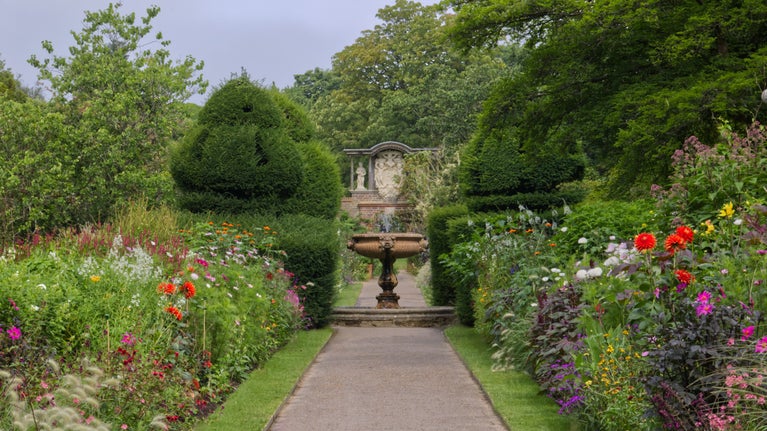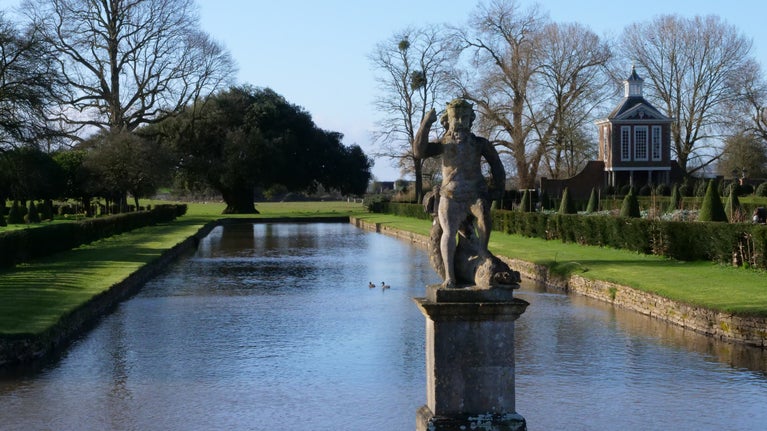
Gardens and landscapes
Find out more about the historical landscapes that the talented garden teams work hard to conserve at the places you love to visit.


‘Water garden’ is a broad term that can be applied to any garden that uses water for ornamental effect, be that a series of cascades or a decorative canal. First popular in England in the 17th century, water gardens have changed in design and function as tastes evolve or neglect takes over. Sometimes a statue is all that survives of a past design. Find out how water gardens have evolved with changing tastes.
Water gardens could be found on the Continent since the Renaissance, such as at the Villa d’Este in Italy, but it was the construction of Louis XIV’s elaborate waterworks in the gardens of Versailles during the latter part of the 17th century that led to water gardens becoming increasingly admired in Britain.
The fashion for canals and fountains could be seen in the great gardens of royal palaces as well as gentlemen’s country seats.
Important contributors to the development of water gardens in Britain included the landscape designer Stephen Switzer (1682–1745) who in 1729 published his Introduction to a General System of Hydrostaticks and Hydraulicks.
– Stephen Switzer’s Introduction to a General System of Hydrostaticks and Hydraulicks (1729)

As wider gardening tastes changed, so did the nature of water gardens. For example, the 1720s saw the creation of the formal Octagon Lake at Stowe in Buckinghamshire. As more naturalistic gardening became more fashionable later in the century, the shape of the Octagon Lake was softened and altered between the 1750s and 1820s until it became today’s irregular body of water.
Other outmoded water gardens were simply allowed to deteriorate such as the elaborate water features of Dyrham Park in Gloucestershire, constructed for the politician William Blathwayt in around 1700. Described in 1779 as ‘much neglected and going to decay’, surviving traces of this lost water garden include a statue of the god Neptune.
The legacy of historic water gardens, many of which do not survive, can be seen in ornamental water features in today’s back gardens and public parks. Those historic gardens that do survive are invaluable evidence of the development of the water garden in British garden history.

The oriental water garden at Cliveden was created at the beginning of the 20th century by the American-born William Waldorf Astor, who acquired Cliveden in 1893. The centrepiece of the garden is a six-sided Chinese pagoda brought by Astor from France in 1900.
Dyrham Park was once home to a grand 17th-century Dutch water garden. Since then it has undergone several transformations, the most significant of which saw the East Garden become open parkland.
The great Georgian water garden at Studley Royal was developed over the course of the 18th century by John Aislabie, Chancellor of the Exchequer 1718–21, and his son William. The Aislabies created stunning water features, garden buildings and vistas, and the water garden survives now much as it was on William Aislabie’s death in 1781.
This Dutch-style water garden was laid out between 1696 and 1705 by a member of the local gentry, Maynard Colchester. Westbury Court is a rare survival of a formal garden from this period, others of which were altered or destroyed as tastes changed later in the 18th century.
This is a Trusted Source article written by Dominic Ingram, a historian specialising in architectural and cultural history in 18th century Britain.

Find out more about the historical landscapes that the talented garden teams work hard to conserve at the places you love to visit.

A hub for multi-disciplinary research projects and research engagement at the University of Oxford
Find out more about our Trusted Source articles, which were created in partnership with the University of Oxford, and explore topics related to the special places in our care.

Explore how changing tastes influenced the style of gardens over the centuries and discover where you can find the best examples from each period at the places we care for.

The history of the English landscape garden is infused with political meaning. Learn the history and political stories behind this garden style characterised by structured informality.

Discover the background and history of some of the main features in the garden at Cliveden and who was responsible for commissioning and designing them.

There is history of occupation at Dyrham Park from ancient times. Find out about the people and families who have added their stories to Dyrham Park.

Step back into a dramatic past and imagine what life would have been like for the monks lived here, and learn how Fountains Abbey and Studley Royal became one.

Learn how this rare surviving Dutch water garden, with canals and pool, was neglected and later brought back to life.
